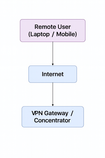Site-to-Site VPN: Connecting Branches Securely Across the WAN
- The Itvue Team
- Aug 25
- 2 min read
Author Ermias Teffera
At ITVue Networks, ensuring secure and reliable connectivity between multiple business locations is essential for modern enterprises. Site-to-Site VPNs provide a solution by connecting branch offices, remote sites, and data centers over the internet or private WAN in a secure and seamless manner.
1. What is a Site-to-Site VPN?
A Site-to-Site VPN establishes a permanent encrypted tunnel between two or more locations, allowing users at different sites to communicate as if they were on the same local network. Unlike remote access VPNs, which are user-based, site-to-site VPNs are network-to-network connections.
Key Benefits:
Secure Communication: All traffic between sites is encrypted and protected
Transparent Connectivity: Users at one site can access resources at another site seamlessly
Cost-Effective: Uses public internet instead of expensive dedicated circuits
Scalable: Connect multiple branch offices with central headquarters
2. Types of Site-to-Site VPNs
a) IPsec VPN
The most common site-to-site VPN type
Encrypts traffic at the IP layer between two VPN gateways
Provides confidentiality, integrity, and authentication
Pros: Full network access, strong securityCons: Requires VPN-capable devices at both sites
b) MPLS-Based VPN
Often provided by service providers as a managed WAN service
Combines MPLS backbone with encryption for secure site connectivity
Pros: High performance, reliable, managed service
Cons: Costlier than IPsec over public internet
3. Site-to-Site VPN Architecture
A typical site-to-site VPN setup includes:
Customer Edge (CE) Routers / VPN Gateways at each site
Encrypted IPsec Tunnel over the internet or WAN
Corporate LANs at each site connected via the tunnel
Diagram: Site-to-Site VPN Architecture

VPN gateways handle encryption/decryption.
LANs communicate transparently over the encrypted tunnel.
4. Authentication and Security
IPsec Policies: Encryption (AES-256) and integrity (SHA-256)
Pre-shared Keys or Certificates: For authenticating VPN endpoints
Firewall Rules and ACLs: Control which traffic can traverse the tunnel
Redundancy: Optional secondary tunnels for high availability
5. Site-to-Site VPN Deployment Best Practices
Strong Encryption and Authentication: Use AES-256 and SHA-2 for secure tunnels
Redundant VPN Gateways: Prevent downtime if a device or path fails
Monitor Tunnel Health: Use logs and SNMP monitoring to detect failures
Segment Traffic: Route only necessary traffic through the VPN, avoiding unnecessary load
Simplify Routing: Use static routes or dynamic routing protocols (OSPF/BGP) over the tunnel
6. Real-World Use Cases
Headquarters to Branch Offices: Connect multiple regional offices to HQ securely
Data Center Interconnect: Securely connect production and disaster recovery sites
Mergers & Acquisitions: Quickly link acquired companies’ networks without building new infrastructure
Multi-Cloud Access: Securely connect private cloud and on-premises environments
7. Conclusion
Site-to-Site VPNs provide a secure, scalable, and reliable method for connecting multiple enterprise locations over the internet or WAN. By leveraging IPsec or MPLS-based VPNs with strong encryption and redundant gateways, ITVue Networks ensures seamless communication, high availability, and network-wide security for all sites.










Comments